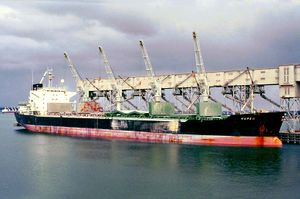Hupeh IV
Contents
History
A British Shipbuilders "B45" standard design handymax bulk carrier, built by Sunderland Shipbuilders.
She took 840,000 man hours to build; just twice as many man hours as the Mitsui 40, "Hunan IV". Anyone looking for an explanation of the end of British shipbuilding need look no further.
She was fitted with a Clark Kincaid B&W and with a quite elaborate system for saving fuel by using exhaust heating a Senior Green exhaust gas boiler to drive a Peter Brotherhood turboalternator. Alas, this was misconceived, as in the nature of things it would only work at 90% MCR and a tramp bulk carrier in a weak market never runs at 90% MCR! She also had zinc rich paint on the decks; another fad of the day.
Her accomodation block was finished in the British Rail Waiting Room style favoured by British Shipbuilders.
Feb 1984. Delivered as "Hupeh" for Taikoo Navigation, CNCo. as managers.
1990. Sold to P.Meyer's A/S Havtor Management, Oslo. Renamed "Havsul". Hull painted grey. She was immediately placed by Havtor in the Bulkhandling pool, which had rejected her, when new (see PROBO BAONING and PROBO BARO) and promptly became the highest earning ship in the pool.
1995. Renamed "China Prospect".
2001. Renamed "Huawanghai".
2004. Renamed "SJN Orcas".
2004. Renamed "Nadia".
2005. Renamed "Chaos Unity".
2006. Renamed "Capetan Minas".
2008.. Renamed "Good Hope".
2011. Renamed "Infinite Hope", which seems rather a good name for her.
2013. Renamed "Infinite".
June 27th. 2013. Broken up at Alang.
Service
She had been intended for the Scanscot pool, and the letters "Scanscot" could be seen in weld metal on the topsides; however CNCo had lost faith in Scanscot by the time she was delivered.
Always employed on time charter, initially to Italmare, later to EAC.
Events / Stories
On her maiden voyage, with John Milward as Master and Tom Harle as Chief Engineer, she ballasted to Galveston Texas to load rice for Iraq to be discharged at Aquaba, Jordan. The rice to be loaded was not as described in the commercial invoice inasmuch as it was not "new crop"; it was old and it was rat infested. Captain Milward therefore rejected the cargo brought forward; this resulted in the ship being arrested by the shippers who alleged that the rats were already on board - with the assistance of Brookes Bell and the Standard P&I Club's Gaveston correspondents, Royston Rayzon Vickery and Williams, this was sorted out and a cargo of clean new crop rice was loaded.
Whilst in transit in the Suez Canal the Senior Green Diesecon exhaust gas boiler caught fire (defect no. 65 on the defect list).
Investigation by CNCo revealed that twelve other British ships fitted with the same boiler had had fires in them; in all cases these had been put down to "crew negligence" and claimed on underwriters. This was not CNCo's way of doing things in those days; we were quite satisfied that Tom Harle had complied with the maker's instructions as were our experts, and we claimed on the boiler makers, who after a great deal of huffing and puffing and attempts to blame everyone else, including, curiously, the turboalternator makers, admitted liability and paid up.
For most of her career the HUPEH benefitted, like the HUNAN, from a Tuvaluan crew.


